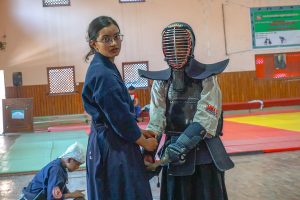Hakama (Skirt-like Pants): 
The hakama, worn over the protective gear, is a symbol of honour, dignity, and tradition in Kendo. Additionally, the hakama’s flowing movement during practice serves as a visual reminder of the fluidity and grace required in mastering Kendo techniques.
Men (Helmet):

The men, or helmet, is a vital piece of protective gear worn by Kendo practitioners. This protects their head and face. Its design not only provides protection to the head but also represents the warrior spirit and readiness for battle. It’s like saying they’re ready for anything.
Do (Body protector):  The do, or body protector, shields the torso and vital organs during training and Keiko. Its curved shape not only offers protection but also embodies the idea of resilience and flexibility, essential qualities for any Kendo practitioner.
The do, or body protector, shields the torso and vital organs during training and Keiko. Its curved shape not only offers protection but also embodies the idea of resilience and flexibility, essential qualities for any Kendo practitioner.
Kote (Gloves):

The kote, or gloves, protect the hands and wrists from strikes and cut. They need their hands to hold the sword just right.
Tare (Waist Protector):  The tare, or waist protector, guards the lower body from attacks aimed at the abdomen and groin. Its symbolic significance lies in its role as a reminder of humility and self-discipline, as it covers the lower body, a vulnerable area in combat.
The tare, or waist protector, guards the lower body from attacks aimed at the abdomen and groin. Its symbolic significance lies in its role as a reminder of humility and self-discipline, as it covers the lower body, a vulnerable area in combat.
Tenugi (Cotton Cloth):

In Kendo, Tenugi refers to a small rectangular cloth worn by practitioners of the martial art. The tenugi is worn around the head, under the men (protective face mask), to absorb sweat and provide additional padding for comfort and safety during intense training or matches. Traditionally, tenugi is white, but some practitioners may choose coloured or patterned tenugi for personal preference or to represent their dojo (training hall).
Shinai (Bamboo stick):

The shinai is a bamboo sword used in kendo practice. It’s lightweight and flexible, designed for safety. Practitioners use it for drills, forms, techniques, and sparring. It symbolizes the samurai spirit and requires respect and care in handling.
Each piece of clothing in Kendo tells a story. It’s not just about preparing themselves physically for training but also about showing respect, staying safe, and being ready to learn and grow. With each strike and movement, practioners embody the spirit of the samurai, upholding principles of respect, discipline, and self-improvement on and off the dojo floor.

